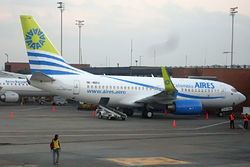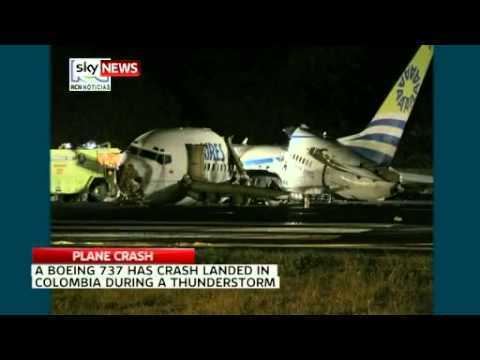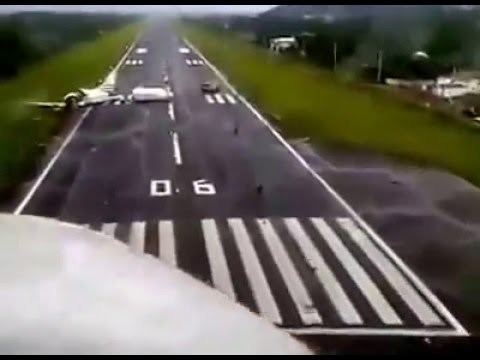Passengers 125 Fatalities 2 Aircraft type Boeing 737-73V Number of deaths 2 Injuries (nonfatal) 119 | Crew 6 Survivors 129 Date 16 August 2010 Summary Pilot error Operator LATAM Colombia | |
 | ||
Similar Taban Air Flight 6437, Agni Air Flight 101, 2010 Karachi Beechcra, Katekavia Flight 9357, Aviastar‑TU Flight 1906 | ||
AIRES Flight 8250 was a domestic scheduled passenger flight which crashed on 16 August 2010 on the Colombian island of San Andrés, in the Caribbean, with two fatalities. The aircraft, an AIRES-operated Boeing 737-73V, was en route from the Colombian capital Bogota when it crashed while attempting to land in bad weather, breaking up into three sections on impact with the runway. It was the second fatal accident involving a 737-700, and the first 737-700 accident leading to the aircraft being written off.
Contents
Aircraft

The aircraft involved was a Boeing 737-73V, registration HK-4682, with serial number (MSN) 32416, construction number 1270. The aircraft had its maiden flight on 10 January 2003, before it was delivered to another airline. It was subsequently delivered to AIRES on 6 March 2010. Investigators said the day after the crash that the aircraft's maintenance log was up to date. The accident was the first that resulted in a Boeing 737-700 being written off.
Flight

The flight was operated by the local, privately owned Colombian airline, AIRES. The aircraft was on a flight from the Colombian capital of Bogota, to the Colombian island of San Andrés, in the Caribbean. A popular tourist destination, San Andres Island is about 190 kilometres (100 nmi) east of the Nicaraguan coast.

The flight took off from Bogota shortly after midnight. Operating as Flight 8250, it departed from El Dorado International Airport at 00:07 en route to Gustavo Rojas Pinilla International Airport. The flight crew consisted of Captain Wilson Gutiérrez and First Officer Camilo Piñeros Rodríguez.
Accident

The crash occurred as the aircraft landed on San Andrés, at 1:49 am local Western Caribbean Time (UTC−05:00). The Boeing 737 broke up into three main sections. The impact occurred about 260 feet (80 m) before the start of the runway, with wreckage spread about another 328 feet (100 m). The aircraft skidded along the runway, fracturing the landing gear and ripping one engine from the wings. The aircraft's nose and first eight rows of seating came to rest on the runway pointing in a different direction to the rest of the wreckage. According to Colonel David Barrero of the Colombian Air Force, "the skill of the pilot kept the plane from colliding with the airport". The engines shut down on impact, and the fuselage did not catch fire. Airport fire crews quickly doused a small fire that had started on a wing. As a result of the accident, the Comité Regional de Prevención y Atención de Desastres was mobilized.
Passengers and crew

There are contradictory reports as to how many people were aboard the aircraft. Reports range from 121 passengers and 6 crew members, 131 passengers and crew, and at least 127 people aboard. The report of 131 people was further broken down as 121 adult passengers and four minors. Reports the day after the accident, settled on 131 people aboard: 125 passengers and 6 crew.
There were two fatalities. Autopsy revealed that a 68-year-old woman suffered a ruptured aorta and ruptured liver. She died on the way to the hospital. One early report stated that 114 people were injured in the crash, and that of 99 passengers taken to the Amor de Patria Hospital on San Andrés, only 4 had suffered major injuries. Reports a day later settled on a figure of 119 people being taken to local hospitals, mostly with minor injuries. Thirteen survivors, including four with serious injuries, were flown to Bogota for treatment. The second fatality was a girl; she sustained substantial brain damage and died 16 days after the accident.
One report stated that the passenger list included six Americans, five Mexicans, four Brazilians, four Ecuadorians and two Germans, the rest being Colombians. Another report stated there were three Americans aboard. A later report put the number of non-Colombians aboard as 'at least 16'.
Investigation
Colombia's civil aviation authority, Special Administrative Unit of Civil Aeronautics, and the Colombian Air Force opened an investigation into the accident. The airport was closed as investigators examined the wreckage. The closure was expected to last until 06:00 on 17 August.
The aircraft reportedly crashed in bad weather, while a storm was reported in the area, but not at the airport. The METAR (aviation routine weather observation message) report in force at the time of the accident indicated that the wind was from the east north east at 6 knots (11 km/h), visibility was good and that the runway was wet. The aircraft "landed in the middle of an intense electrical storm" according to Colonel Barrero.
Passenger accounts the day after the crash detailed how the approach appeared to have been going normally, with the flight attendants having made the passengers ready for landing, when the crash occurred suddenly and without warning. The pilot did not report an emergency to the tower. There were conflicting reports over what caused the crash, suggesting that the landing was disrupted after the aircraft was hit by a downdraft, or struck by lightning. The pilot said that the aircraft was struck by lightning. Officials refused to comment on the reports of a lightning strike, although subsequent research proved that was not true. No aircraft has had an accident caused by lighting since 1971. The airport was not fitted with equipment such as a Doppler radar, used to detect wind shear.
Both the flight data and cockpit voice recorders were recovered from the wreckage. Based on the pattern of wreckage, investigators concluded that the aircraft had broken up on impact and not while in the air.
The U.S. National Transportation Safety Board sent a team to support the Colombian-led investigation as representatives of the manufacturer's state.
Almost one year after the accident, on 15 July 2011, the Security Council of Aeronáutica Civil concluded that it was an error of the pilot, who did not correctly adjust to the bad weather and high winds, touching ground before the runway; and stated "the pilot entered at a low altitude and the strong winds knocked down the aircraft". Aeronaútica Civil recommended retraining of the crew. Although the accident was caused by human error, Aeronaútica representative Colonel Carlos Silva reminded that the purpose of the investigation was not to apportion blame but to prevent aircraft accidents that may occur in the future.
